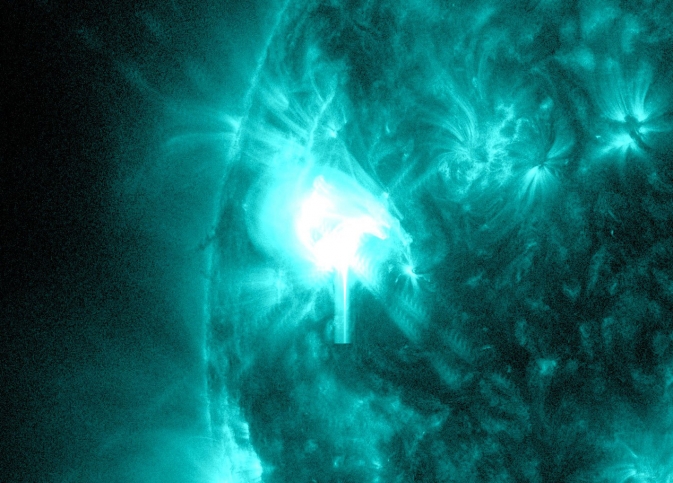Mid-level Solar Flare Erupts from the Sun

The bright light on the left side of the sun shows an M5.2-class solar flare in progress on May 8, 2014.This image, captured by NASA's SDO, shows light with a 131 Angstrom wavelength, which highlights the extremely hot material in a solar flare and is typically colorized in teal. Image Credit: NASA/SDO
Solar flares are powerful bursts of radiation.
Harmful radiation from a flare cannot pass through Earth's atmosphere to physically affect humans on the ground, however — when intense enough — they can disturb the atmosphere in the layer where GPS and communications signals travel.
To see how this event may impact Earth, please visit NOAA's Space Weather Prediction Center at http://spaceweather.gov, the U.S. government's official source for space weather forecasts, alerts, watches and warnings.
This flare is classified as an M5.2-class flare. M class flares are on the order of a tenth as strong as the most intense flares, the X-class flares.
Updates will be provided as needed.
What is a solar flare and what is M-class?
For answers to these and other space weather questions, please visit the Spaceweather Frequently Asked Questions page.
Related Link
Karen C. Fox
NASA's Goddard Space Flight Center, Greenbelt, Md.
Media Contact
All latest news from the category: Physics and Astronomy
This area deals with the fundamental laws and building blocks of nature and how they interact, the properties and the behavior of matter, and research into space and time and their structures.
innovations-report provides in-depth reports and articles on subjects such as astrophysics, laser technologies, nuclear, quantum, particle and solid-state physics, nanotechnologies, planetary research and findings (Mars, Venus) and developments related to the Hubble Telescope.
Newest articles

Combatting disruptive ‘noise’ in quantum communication
In a significant milestone for quantum communication technology, an experiment has demonstrated how networks can be leveraged to combat disruptive ‘noise’ in quantum communications. The international effort led by researchers…

Stretchable quantum dot display
Intrinsically stretchable quantum dot-based light-emitting diodes achieved record-breaking performance. A team of South Korean scientists led by Professor KIM Dae-Hyeong of the Center for Nanoparticle Research within the Institute for…

Internet can achieve quantum speed with light saved as sound
Researchers at the University of Copenhagen’s Niels Bohr Institute have developed a new way to create quantum memory: A small drum can store data sent with light in its sonic…





















